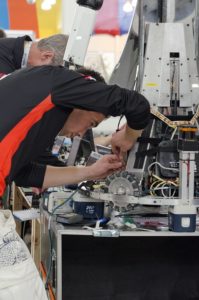
BMC Neuroscience: Effect of pulsed transcranial ultrasound stimulation at different number of tone-burst on cortico-muscular coupling
Neuromodulation can be defined as “the alteration of nerve activity through targeted delivery of a stimulus, such as electrical stimulation or chemical agents, to specific neurological sites in the body.” A growing area of research in the field of neuromodulation has been centered around its potential effects on the motor cortex. Successful neuromodulation of the motor cortex could promise life-changing implications for those affected by movement disorders brought on by stroke and diseases such as Parkinson’s disease and Amyotrophic Lateral Sclerosis (ALS).
The results of this research highlight the potential of neuromodulation, and pTUS specifically, as a potential future treatment for motor dysfunctions.
A promising neuromodulation technique shown to affect the motor cortex is pulse transcranial ultrasound stimulation (pTUS). This method uses pulsed low-frequency ultrasound to harmlessly penetrate deep into brain tissue and can be targeted specifically towards brain waves which affect muscle activity.
Recently, researchers published a study in BMC Neuroscience which looked at the effect pTUS had on the cortico-muscular coupling (mind-muscle connection) between the motor cortex and tail muscles in mouse subjects. Researchers, Xie et al tested different tone bursts and evaluated the effect they had on the muscle activity of the mice.
Xie and colleagues found that significant differences in the cortico-muscular coupling activity of mice resulted from an increasing number of tone-bursts, from 150 – 300, at 1kHZ. The results of this research highlight the potential of neuromodulation, and pTUS specifically, as a potential future treatment for motor dysfunctions.
BMC Pediatrics: Procedural pain in children: a qualitative study of caregiver experiences and information needs
Pediatric medical patients are often not as resilient to the pain associated with common invasive medical procedures, such as venipuncture, when compared to their adult counterparts.
Researchers, Shave et al, published this study in BMC Pediatrics where they took a qualitative, interview-based approach at assessing child caregivers’ understanding and perspective towards pain associated with pediatric medical procedures.

The results of the survey saw that caregivers were generally satisfied with the pain management practices that healthcare providers afforded their pediatric patients. However, study participants showed further emphasis toward the value of providing extra information to caregivers and pediatric patients, regarding the purpose of the procedures, as well as what to expect in terms of pain or discomfort.
Lastly, participating caregivers further suggested that healthcare providers should direct extra effort towards addressing the child specifically, informing them of the sensations and outcomes of the procedure in terms they can understand; as well as allowing the pediatric patients to ask questions and make decisions regarding the procedure whenever possible.
BMC Mechanical Engineering: The BMC Series’ newest journal for the physical sciences, Mechanical Engineering, is now open to submissions

In 2018, the BMC Series announced that it would be expanding its journal portfolio beyond the realm of biology and medicine, and into the physical sciences. BMC Mechanical Engineering is the fourth and latest of these journals to be open for submission. The journal’s scope ranges from articles on “fluid dynamics” to “mechatronics and automation” and much more.
Alexandros Houssein, Ph.D., Editor for BMC Mechanical Engineering, recently published a blog announcing the journal’s launch and detailing the importance of the new open access platform now available to the mechanical engineering research community.
Dr. Houssein speaks on behalf of the journal’s ethos by stating, “BMC Mechanical Engineering embraces this diversity of subjects and comes to support a large and international research community. With a focus on championing open access research, it aims to advance scientific discovery by making research freely accessible across the world.”
BMC Biotechnology: A highly parallel strategy for storage of digital information in living cells

The storage of digital information in DNA has recently gained a lot of attention due to its promise of high-volume, and extremely long-term, storage potential. While DNA digital data storage is currently possible and being utilized, improvements to methodologies are necessary to realize the full potential of this fascinating and efficient storage model.
Researchers, Akhmetov et al, have recently published an article in BMC Biotechnology where they detail their development of a novel DNA digital data storage method. Their “parallelized” storage method aims to capitalize on the weaknesses of previously established methodologies, allowing for better long-term storage, built-in error detection, increased efficiency, and a redundant reading process that allows for the collection of data even if the DNA is damaged.
The development of better DNA digital storage methodologies will be fascinating developments to witness as we make it feasible to store immense datasets for longer terms than previously thought possible, all using the building blocks of life itself.
BMC Chemical Engineering: AIChE Annual Meeting 2018: An interview with the chair of BMC Chemical Engineering on the importance of publishing, and benefits of open access
Just prior to the 2018 annual meeting for the American Institute of Chemical Engineers, the chair of BMC Chemical Engineering, Dr. Sang Yup Lee, participated in an interview where the importance of scientific publishing was discussed.
Dr. Lee began by discussing how, over the years, the field of Chemical Engineering has been constantly adapting its principles and practices to remain useful, and in some cases essential, to various scientific disciplines. Dr. Lee even asserted, “Chemical engineering has been, is and will be at the core of all industries, including energy, chemicals, materials, medicine, agriculture, and environmental sustainability.”
“Peer-reviewed work published in high-quality journals advances science and engineering, particularly when the research is published open access”
With all this information being generated by chemical engineers across such a wide field of disciplines, Dr. Lee went on to emphasize the importance of publication and the open access model: “Publishing in scientific journals is one of the most important media for the dissemination of research outputs. Peer-reviewed work published in high-quality journals advances science and engineering, particularly when the research is published open access.”
BMC Public Health: Investigating the growing trend of non-drinking among young people; analysis of repeated cross-sectional surveys in England 2005–2015
England’s youth have been experiencing an increasing trend in alcohol abstention, which has been wholly celebrated from a public health standpoint. Among citizens aged 16 to 24, the rate of self-reported “non-drinkers” has risen from 18% in 2005 to 29% in 2015.

An article recently published in BMC Public Health aimed to look at the ways in which non-drinking behavior has been increasing among the young adult population in the UK.
The study evaluated whether specific subgroups have been experiencing a disproportionate increase in non-drinking, as well as whether rates of problematic drinking behaviors, such as binge drinking, are changing as well.
Researchers Fat et al, utilized a qualitative, survey-based approach, where trained interviewers administered a face-to-face interview inside participants’ homes. The study revealed that rates of non-drinking are on the rise across most of its practices, the only exception being that of ex-drinkers, which saw neither an increase or decrease in prevalence.
The results of the study also showed that, overall, non-drinking behavior is increasing across many subgroups, including subgroups that are already associated with non-drinking behavior. Young adults are also engaging in problematic drinking behaviors less, as rates of overdrinking and binge drinking are lower than previously reported.
Interestingly, the study also found no significant association between non-drinking and any one single factor in particular, suggesting that the change may be “multi-factorial or cultural.”
BMC Palliative Care: Access to palliative care for homeless people: complex lives, complex care
Homeless individuals lack many things considered essential, appropriate health care should not be one of them. In the year 2000, the United Nations stated: “Health is a fundamental human right indispensable for the exercise of other human rights. Every human being is entitled to the enjoyment of the highest attainable standard of health conducive to living a life in dignity.” Despite this policy, it has been shown that the homeless population is still not afforded an appropriate level of care, especially for end of life palliative care.

Authors of an article recently published in BMC Palliative Care detail their findings from their study on the quality of palliative care provided to the homeless population in the Netherlands. De Veer et al conducted quality in-depth interviews with over 50 participants, including homeless individuals, nurses, case workers, and physicians. The interviews were used to reconstruct the cases of 19 homeless individuals who are or have previously experienced palliative care, 11 of which had already passed away.
Compared to the non-homeless population, homeless individuals were found to experience several key themes that prevented them from experiencing adequate palliative care, namely: late access to palliative care, capricious health care trajectories, and a high degree of complexity associated with care.
Comments